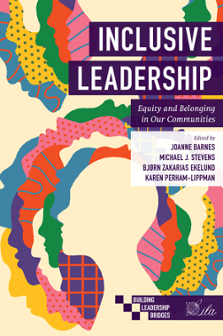
Index
Inclusive Leadership: Equity and Belonging in Our Communities
ISBN: 978-1-83797-441-2, eISBN: 978-1-83797-438-2
ISSN: 2058-8801
Publication date: 16 October 2023
Citation
(2023), "Index", Barnes, J., Stevens, M.J., Ekelund, B.Z. and Perham-Lippman, K. (Ed.) Inclusive Leadership: Equity and Belonging in Our Communities (Building Leadership Bridges, Vol. 9), Emerald Publishing Limited, Leeds, pp. 267-275. https://doi.org/10.1108/S2058-880120230000009024
Publisher
:Emerald Publishing Limited
Copyright © 2024 Emerald Publishing Limited
INDEX
(see also L-BL Achieving Styles Mode)
(see also Global curiosity)
- Prelims
- Part One: Understanding Diversity, Equity, Inclusion, and Belonging
- Chapter 1: Shared Equity Leadership: A New Model for Making Inclusion and Equity Part of Organizational Culture
- Chapter 2: Inclusive Leadership and Power
- Chapter 3: Cultural Humility and Inclusion: Transformation to a Culture of Belonging
- Chapter 4: The Impact of Colonialism on Inclusion and Belonging in Organizations
- Part Two: Diversity, Equity, Inclusion, Belonging, and Education
- Chapter 5: The Development of Future Leaders' Inclusive Competencies: Lessons From a Business Management Course
- Chapter 6: Advancing Gender Equality in Higher Education in South Africa: Emboldening Women Leaders in Complex Contexts
- Chapter 7: Building Diverse and Inclusive Faculty Teams: Practices in Inclusive Leadership in Higher Education
- Chapter 8: Inclusive Leadership for Social Justice: DEIB Leadership Programs and Organizations
- Chapter 9: Addressing the Goal of Inclusive and Equitable Quality Education and Lifelong Learning for All
- Chapter 10: Research–Practice Partnership to Reform Special Education Service Delivery in Boston Public Schools
- Part Three: The Application and Practice of Diversity, Equity, Inclusion, and Belonging/Accessibility
- Chapter 11: An Inclusive Language of Diversity
- Chapter 12: Inclusive Leadership: Guide and Tools
- Chapter 13: How Inclusive Leaders Can Influence Employee Engagement
- Chapter 14: Fostering an Inclusive Organization Through the Power of Storytelling
- Chapter 15: Achieving Societal Equality by Building Inclusive Corporate Boards
- Part Four: Diversity, Equity, Inclusion, Belonging/Accessibility: A Community and Global Perspective
- Chapter 16: Creating Inclusive Leadership in Rural Communities: Lessons Learned in Rural Minnesota
- Chapter 17: Inclusive Leadership From a Force Commander's Perspective
- Chapter 18: Diversity From an Organizational Perspective: Building a Culture
- Chapter 19: Decolonization and Inclusion: Widening the Circle
- Chapter 20: Muslimophobia: Overcoming Religious Discrimination and Exclusion in the Workplace
- Chapter 21: The Reciprocity of Dignity: Transforming Us/Them Narratives Through Inclusive Dialogue
- Chapter 22: Social Justice Leader Case Studies Assessed Through the Lens of Connective Leadership™
- Chapter 23: Iran's Woman Life Freedom Movement: How Leadership Emerged
- Index